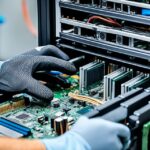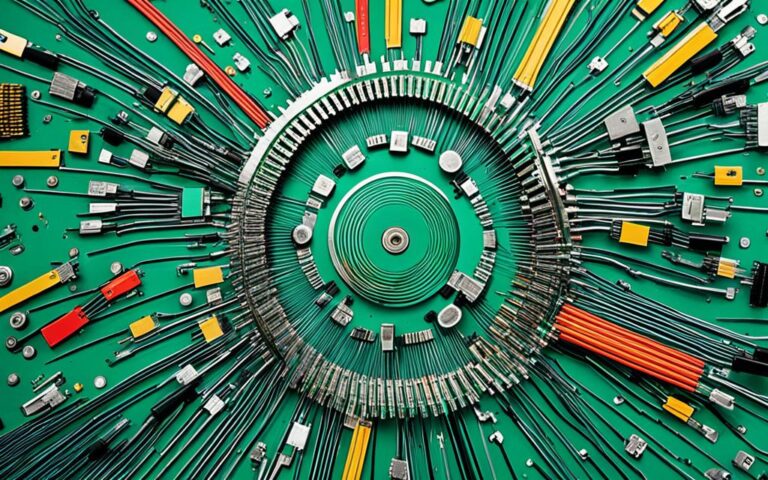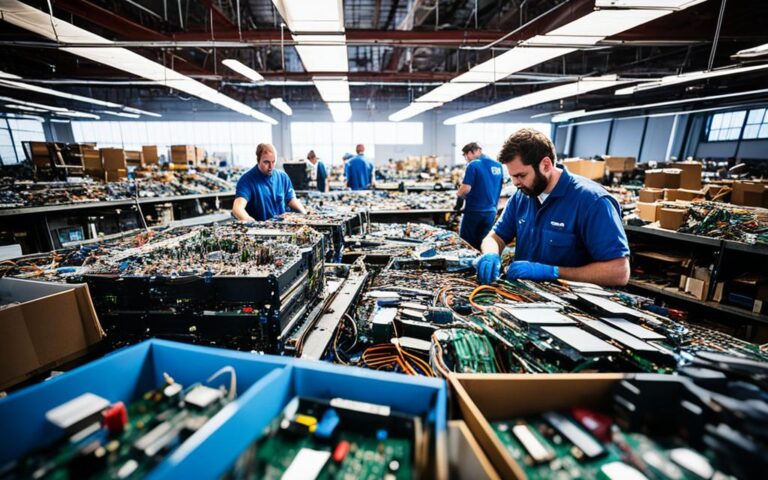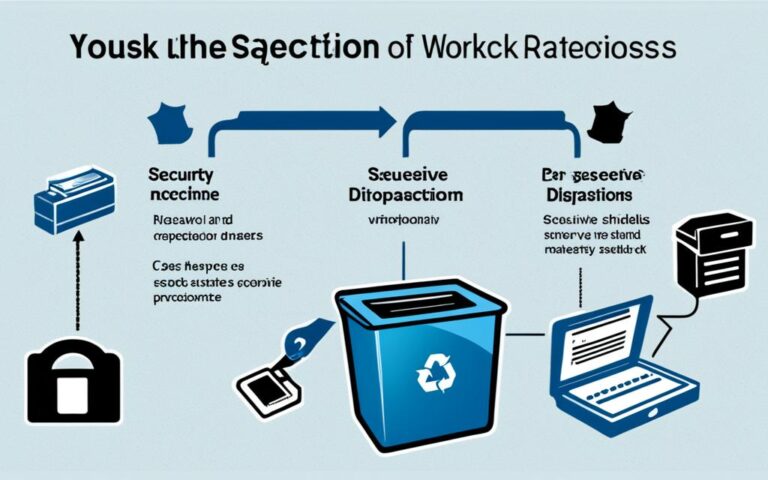Desktop Renewal: Strategies for Extending Lifecycles
The lifespan of desktop computers is typically around 5 years, while laptops have an even shorter lifespan. This poses a challenge for businesses that rely on IT equipment like smartphones, barcode scanners, sales terminals, and payment terminals. Manufacturers often impose limitations on the lifespan of their products, which can disrupt a company’s IT strategy. According to a survey, the average lifespan of desktop computers is 5 years for 70% of companies, while business laptops last 5 years for 48% of companies. Smartphones are used for 3 to 4 years on average, with many being replaced even when they are still functional. The lifecycles of peripherals like servers and printers also align with PCs, lasting around 5 years for most companies.
To overcome these limitations and extend the lifespan of IT equipment, companies have several options, including buying refurbished equipment, investing in maintenance, using spare parts, or recycling unused equipment. These strategies can help businesses optimize their IT investments, reduce costs, and align with sustainable IT practices.
Extending Lifecycles with Refurbished Equipment
Buying refurbished IT equipment can be a cost-effective way to extend the lifespan of a company’s IT fleet. Refurbished equipment offers several advantages:
- Maintaining fleet consistency: By purchasing refurbished equipment, companies can ensure that their IT fleet remains consistent in terms of hardware models and specifications.
- Avoiding the need for new furniture and racks: Refurbished equipment allows businesses to use their existing infrastructure, saving them the cost of purchasing additional furniture and racks to accommodate new equipment.
- Readily available stock: Refurbished equipment is often readily available, allowing companies to quickly replace outdated or malfunctioning devices without experiencing downtime.
- Accessing lower prices: Refurbished equipment is typically priced lower than new equipment, enabling companies to save on their IT budgets.
- Using the same software version: With refurbished equipment, companies can continue using the same software version, eliminating the need for additional development costs associated with upgrading to new equipment.
- Contributing to a company’s CSR efforts: Opting for refurbished equipment aligns with sustainable practices, as it reduces electronic waste and supports circular economy principles.
Refurbished Equipment: Ensuring Functionality and Security
Before being put back into the market, refurbished equipment undergoes an extensive audit procedure to ensure functionality and security. This includes testing, repair, and reconditioning of the equipment. Personal data is securely erased and protected, ensuring privacy compliance. By choosing refurbished equipment, companies can break free from manufacturers’ planned lifecycles and take more control over their IT strategy.
Table: Advantages of Refurbished Equipment
| Advantage | Description |
|---|---|
| Maintaining fleet consistency | Ensures hardware consistency across the IT fleet |
| Avoiding the need for new furniture and racks | Saves costs associated with purchasing new infrastructure |
| Readily available stock | Allows quick replacement of outdated or malfunctioning devices |
| Accessing lower prices | Offers cost savings compared to new equipment |
| Using the same software version | Eliminates additional development costs |
| Contributing to a company’s CSR efforts | Promotes sustainability and circular economy practices |
Maximizing Lifespan through Maintenance
Another effective strategy for extending the lifespan of IT equipment is through professional maintenance services. By partnering with a reliable computer maintenance service provider, companies can go beyond the manufacturers’ warranty periods, thereby improving the overall lifespan of their IT fleet.
One of the key advantages of investing in maintenance services is the ability to avoid delays in the delivery of new equipment. This is particularly important during the deployment of new systems or software updates, as maintenance ensures a cohesive IT infrastructure without disrupting daily operations.
Moreover, regular maintenance helps to minimize breakdowns and breakages, reducing the risk of unexpected downtime and the associated costs. By conducting routine inspections, identifying potential issues, and proactively addressing them, companies can ensure the optimal performance and longevity of their IT assets.
“Maintenance services offer the opportunity to repair and improve equipment performance through the use of spare parts.”
Maintenance services also provide an excellent opportunity for equipment repair and performance improvement. By utilizing spare parts, technicians can replace faulty components and enhance the functionality of IT assets. This approach not only extends the lifespan of computers and other devices but also saves costs associated with premature equipment replacement.
Advantages of Maintenance Services
- Improved lifespan of IT equipment beyond manufacturers’ warranty periods
- Avoidance of delays in new equipment delivery during system deployments
- Reduced breakdowns and breakages, leading to decreased downtime
- Repair and improvement of equipment performance through spare parts
- Optimization of IT investments and cost reduction
To further illustrate the benefits of IT asset maintenance, let’s consider the case of a multinational retail company. By investing in regular maintenance services, the company experienced a significant reduction in computer failures and subsequent disruptions to their operations. As a result, they were able to extend the lifespan of their IT fleet, optimize their IT investments, and reduce the overall cost of maintaining their IT infrastructure.
By prioritizing maintenance and taking a preventive approach, businesses can maximize the lifespan of their IT assets, ensure consistency and reliability in their operations, and ultimately achieve cost-effective IT management.
Leveraging Spare Parts for Long-term Use
The use of spare parts can significantly contribute to extending the lifespan of IT equipment. It is important to differentiate between “end of life” and “end of use” when it comes to business IT equipment. Many companies mistakenly believe that end-of-use means the end of a product’s life, leading to premature replacement. However, by utilizing spare parts and repairing equipment, companies can delay the end of a product’s useful life. Spare parts can be used to repair equipment and improve its performance, ensuring long-term use.
Companies can leverage various spare parts to address different repair needs of their IT equipment. This not only helps in fixing specific issues but also enhances the overall performance and functionality of the devices. By reusing components such as processors, memory modules, hard drives, and power supplies, businesses can extend the lifespan of their IT assets without the unnecessary cost of replacing entire systems. Additionally, spare parts can also be used to upgrade or enhance existing equipment, enabling companies to keep up with the evolving technological landscape.
By implementing a process of reusing equipment and leveraging spare parts, companies can further extend the IT life cycle and adopt a sustainable approach that aligns with their corporate social responsibility (CSR) policies. This not only reduces electronic waste but also helps in conserving valuable resources and minimizing the environmental impact of IT equipment disposal. Service providers like Codeo, who specialize in spare parts management and equipment refurbishment, play a crucial role in facilitating the reuse, reconditioning, and recycling of unused equipment. They ensure the security of data during the refurbishment process and provide businesses with a reliable source of spare parts.
In conclusion, leveraging spare parts for IT equipment repair and long-term use offers multiple benefits. It allows companies to extend the useful life of their devices, improve performance, and reduce unnecessary expenditures on premature replacements. Moreover, by adopting a sustainable approach to IT asset management, businesses can minimize their environmental footprint and contribute to a more circular economy.
Benefits of Utilizing Spare Parts for IT Equipment Repair:
- Extended lifespan of IT equipment
- Improved performance and functionality
- Cost-effective alternative to replacing entire systems
- Upgradability and compatibility with evolving technology
- Conservation of resources and reduction of electronic waste
- Alignment with corporate social responsibility (CSR) policies
A Case Study in Spare Parts Management:
Company XYZ, a leading technology firm, implemented a spare parts management strategy to optimize the lifespan of their IT equipment. By refurbishing and reusing spare components, they were able to extend the useful life of their devices by an average of 2 years. This resulted in significant cost savings and reduced environmental impact. Additionally, Company XYZ partnered with Codeo to ensure the secure disposal and recycling of end-of-life equipment, further enhancing their commitment to sustainable IT practices.
| Spare Parts | Repair Needs | Benefits |
|---|---|---|
| Processors | Improving processing speed | Enhanced overall performance |
| Memory Modules | Increasing system memory | Improved multitasking capabilities |
| Hard Drives | Recovering data and increasing storage capacity | Preservation of valuable information |
| Power Supplies | Fixing power-related issues | Stable and reliable operation |
By strategically utilizing spare parts, businesses can ensure the longevity of their IT equipment while maximizing performance and minimizing environmental impact. Incorporating spare parts management into their IT asset management strategy allows companies to optimize their IT investments and embrace sustainable practices that benefit both their bottom line and the planet.
Developing an IT Renewal Strategy
IT equipment renewal is a complex process that requires careful planning and strategy. Companies must consider various factors, such as equipment type, technological developments, and user needs, before determining the right time for renewal. A well-executed renewal plan can optimize costs, maintain fleet consistency, and align the IT strategy with overall business goals.
One crucial aspect of IT equipment renewal is the need to maintain a homogeneous IT fleet. Having a uniform set of devices can rationalize maintenance costs and ensure smooth IT operations. It enables companies to streamline processes, reduce complexity, and enhance user experience across the organization. Moreover, a homogeneous IT fleet simplifies software management, compatibility testing, and troubleshooting, making it easier to support and manage the entire ecosystem.
When developing an IT renewal strategy, companies have several options to choose from:
- Complete Renewal: This involves replacing the entire IT fleet with the latest models and technology. While this approach ensures uniformity and takes advantage of the latest innovations, it can be a significant investment.
- Buying Refurbished Equipment: Opting for refurbished IT equipment can offer a cost-effective alternative to complete renewal. Refurbished devices undergo rigorous testing and reconditioning processes, ensuring their functionality and performance. This approach allows companies to extend the lifespan of their IT assets while enjoying substantial cost savings.
- Investing in Maintenance: Partnering with a reliable maintenance service provider can help companies maximize the lifespan of their IT equipment. These services go beyond manufacturers’ warranties, providing timely repairs, software updates, and performance optimizations. Maintenance services help companies avoid costly breakdowns, minimize downtime, and extend the useful life of their IT assets.
It’s important to note that traditional roadmaps and manufacturers’ warranties should not be the sole determining factors for IT renewal. Companies should take control of the renewal process by evaluating their specific needs, budget constraints, and technological advancements. By actively managing their IT renewal strategy, companies can optimize costs, leverage the benefits of a homogeneous IT fleet, and ensure long-term operational efficiency.
The Benefits of a Homogeneous IT Fleet
A homogeneous IT fleet offers several advantages:
- Streamlined maintenance and support processes
- Reduced complexity in software management
- Easier compatibility testing and troubleshooting
- Enhanced user experience and productivity
By focusing on developing a well-rounded renewal plan and maintaining a homogeneous IT fleet, companies can effectively navigate the challenges of IT equipment renewal, optimize their investments, and stay aligned with their long-term business objectives.
Example Table: Comparing IT Equipment Renewal Options
| Renewal Option | Advantages | Considerations |
|---|---|---|
| Complete Renewal | – Ensures uniformity and access to the latest technology – Can improve performance and productivity |
– Significant upfront cost – Disruption in deployment and user familiarization |
| Buying Refurbished Equipment | – Cost-effective alternative to complete renewal – Extends the lifespan of IT assets – Environmental sustainability |
– Limited availability of specific models – Potential variation in performance and cosmetic condition |
| Investing in Maintenance | – Maximizes the lifespan of IT assets – Minimizes downtime and breakdowns – Improves software compatibility and security |
– Ongoing maintenance costs – Need for reliable service providers |
Conclusion
In conclusion, extending the lifecycles of IT equipment is crucial for optimizing performance and minimizing costs. By exploring strategies such as buying refurbished equipment, investing in maintenance, utilizing spare parts, and adopting a process of equipment reuse, companies can break free from manufacturers’ planned obsolescence and have more control over their IT lifecycle. These strategies not only offer cost savings but also align with sustainable and environmentally responsible IT practices. As technology continues to evolve, companies must develop comprehensive IT renewal strategies that prioritize longevity, efficiency, and cost-effectiveness. With the right approach, businesses can maximize the value of their IT investments and contribute to a more sustainable future.
FAQ
How long is the typical lifespan of desktop computers?
The average lifespan of desktop computers is around 5 years for 70% of companies.
What about the lifespan of business laptops?
Business laptops last 5 years for 48% of companies.
How long are smartphones typically used for?
Smartphones are used for 3 to 4 years on average.
What is the lifespan of peripherals like servers and printers?
Peripherals like servers and printers usually last around 5 years for most companies.
What options do companies have to extend the lifespan of IT equipment?
Companies have several options, including buying refurbished equipment, investing in maintenance, using spare parts, or recycling unused equipment.
What are the advantages of buying refurbished IT equipment?
Buying refurbished equipment offers several advantages, including the ability to maintain fleet consistency, access lower prices compared to new equipment, and contribute to a company’s CSR efforts.
How can maintenance services help extend the lifespan of IT equipment?
Maintenance services allow companies to go beyond manufacturers’ warranty periods, reduce breakdowns and breakages, and repair and improve equipment performance through the use of spare parts.
What is the difference between “end of life” and “end of use” for IT equipment?
Many companies mistakenly believe that “end of use” means the end of a product’s life, leading to premature replacement. However, by utilizing spare parts and repairing equipment, companies can delay the end of a product’s useful life.
How can companies develop an IT renewal strategy?
Companies need to consider factors such as equipment type, technological developments, and user needs before determining the right time for renewal. Maintaining a homogeneous IT fleet and choosing from options like complete renewal, buying refurbished equipment, or investing in maintenance can help optimize costs and align IT strategy with business goals.















